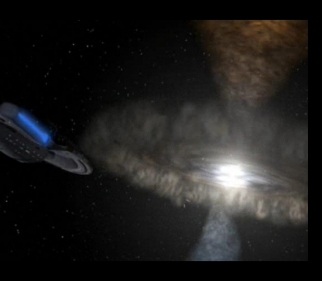|

In Star Trek, an astral eddy is a subspace disruption
anomaly. The phenomenon was first encountered in 2373. A Vostigye
science station, in the Delta Quadrant, was torn apart by an astral
eddy with the temperature gradient of nine million kelvins. Eddies
collapsing back to the interfold layer also trapped a probe and the
shuttlecraft Cochrane, while it was gathering plasma particles with
bussard collectors from the wake of an eddy. (VOY: "Real Life"). An
erupting eddy is shaped like a ring emanating from a whirlpool center.
Within the ring there are massive discharges of plasmatic energy. The
center however is totally calm. Matter inside the anomaly is exchanged
between space and subspace. Astral eddies form inside interfold layers,
between space and subspace. A sufficiently large eddy periodically
erupts into normal space via a subspace rupture. The eddy forms,
expands, moves, dissipates and collapses back into the interfold layer.
Due to the fact that an eddy is highly charged with plasma, it leaves
behind an unusual wake of plasma particles that emanate from subspace.
This wake produces dangerous levels of radiation. A human traveling in
the wake on a class 2 shuttle can temporarily be protected from the
effects with hyronalin and lectrazine.
Astral eddies disable starship propulsion and
navigation. They cause turbulence in the levels that transporters
cannot be used to beam anything to or from the anomaly. An erupting
eddy also produces graviton waves that impact objects further away.
Phasers may be able to disperse an eddy when it erupts into normal
space.
There is no such phenomena termed as astral eddies in
real astrophysics. However, the images used to illustrate astral eddies
in Star Trek very clearly indicate a phenomena similar to a black hole.
Contemporary models proposed to describe the flow into a black hole
from the turbulent flow of matter in initially circular orbits about
the black hole do illustrate the possibility of eddy formations. The
shear between fluid elements at slightly different orbital radii causes
turbulent eddies to be formed. These eddies determine the dissipation
rate of kinetic energy into thermal energy. For approximately circular
orbits, the magnitude of the gravitational potential energy is always
equal to twice the kinetic energy; the destruction of the latter
resulting in a reduction in the orbital radius and hence the potential
energy. In this model, the turbulent eddy rotation period is presumed
to be determined by the gradient in the gravity acceleration, leading
to an eddy period proportional to the orbital period. If the flow
speeds are supersonic but not relativistic, then the turbulent eddy
size is set by the product of the eddy rotation period and the speed of
sound. At a certain smaller radius, the orbital speeds and hence the
dissipation rate are so great that the speeds become relativistic and
the molecular speed tends toward its limit. Then the effective eddy
size is controlled by the product of the eddy rotation period and the
speed of light. Using these estimates for the important eddy size, the
dissipation rate, temperature, density and sinking speed as a function
of the orbital radius and the rate of mass flow into the black hole are
derived.
|
|
